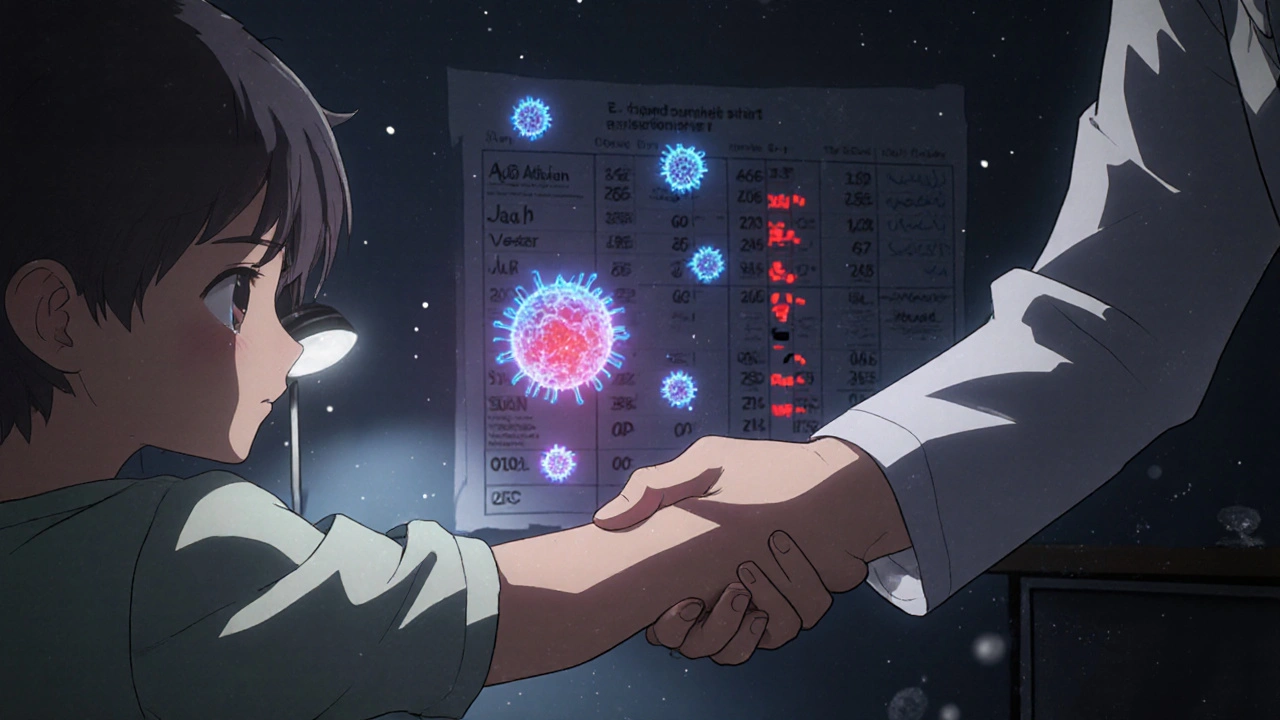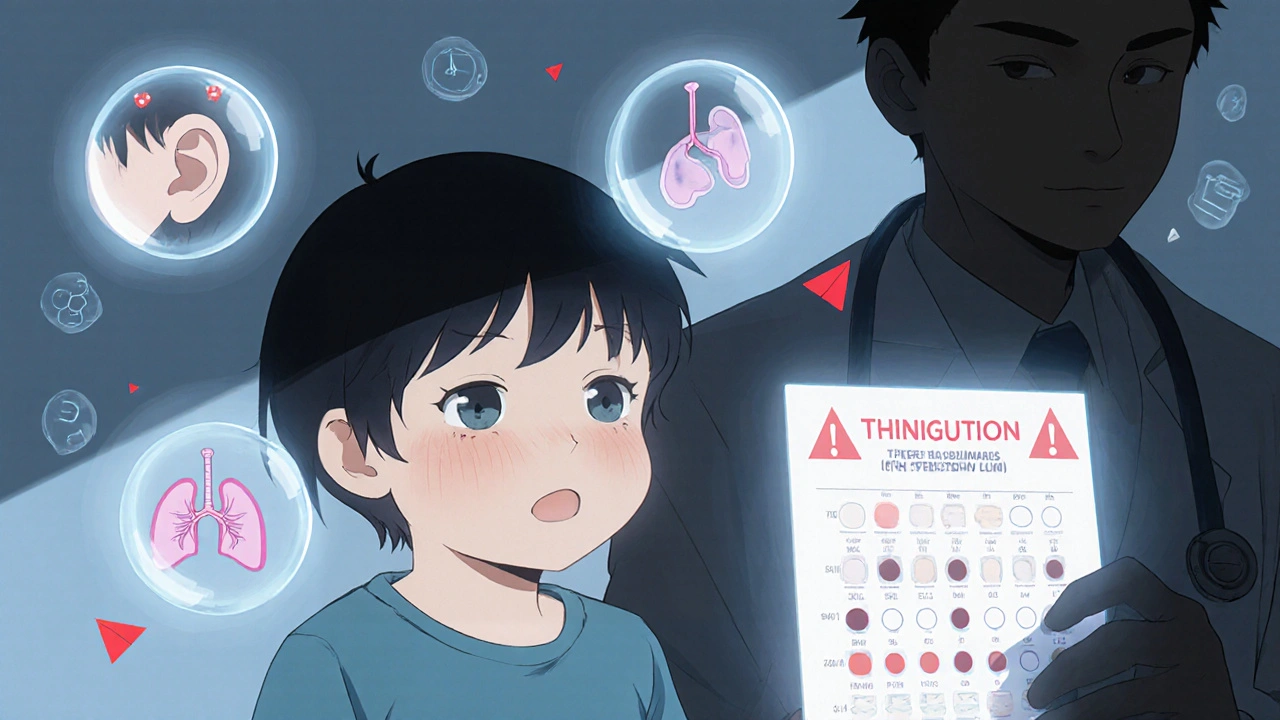When Recurrent Infections Are More Than Just Bad Luck
It’s normal for kids to get sick. A preschooler might have eight colds a year. A teenager might catch the flu once every winter. But when infections keep coming back-same spots, same bugs, same stubbornness-it’s not just bad luck. It could be your immune system isn’t working right.
Primary immunodeficiencies (PIDs) are rare, but they’re not as rare as most people think. About 1 in 1,200 people have one. And the biggest red flag? Recurrent infections. Not just one or two, but patterns that don’t fit the usual story.
The 10 Warning Signs That Demand a Closer Look
Doctors don’t guess. They look for patterns. The Immune Deficiency Foundation and the American Academy of Allergy, Asthma & Immunology agree on key warning signs that mean it’s time to dig deeper:
- Four or more ear infections in one year
- Two or more serious sinus infections in one year
- Two or more pneumonias in one year
- Deep skin or organ abscesses that won’t heal
- Persistent oral thrush after age one
- Infections that don’t get better after two months of antibiotics
- Need for IV antibiotics to clear infections
- Two or more deep-seated infections like septicemia or meningitis
- Failure to gain weight or grow normally
- A family history of early deaths from infections or known immunodeficiency
These aren’t just suggestions. They’re thresholds backed by data. A child with three ear infections might be fine. A child with four? That’s a signal. A 7-year-old with thrush in their mouth? That’s not normal. Thrush after age one has an 89% specificity for antibody deficiency, according to a 2016 study in Clinical Immunology.
What the Physical Exam Reveals
It’s not just about how often someone gets sick. It’s about what the body shows when it’s examined. A doctor checking for immunodeficiency doesn’t just listen to lungs-they look for clues hidden in plain sight.
Absent tonsils or lymph nodes? That’s a major red flag. In 78% of severe combined immunodeficiency (SCID) cases, these are missing. It’s not just small-they’re gone. Skin changes matter too. Telangiectasias-tiny red blood vessels on the skin-are found in 95% of people with ataxia-telangiectasia. That’s not a coincidence. It’s a signature.
Growth is another silent indicator. If a child is below the 5th percentile for height or weight, and they’ve had repeated infections, that’s a red flag. One study in Pediatrics found 63% of children with PIDs showed failure to thrive before diagnosis.
How the Workup Starts: Blood Tests That Matter
Once red flags show up, the next step isn’t a guess. It’s science. The first test is a complete blood count (CBC) with manual differential. In kids over one year, a lymphocyte count below 1,500 cells/μL suggests T-cell problems. In babies under one, anything under 3,000 is a concern.
Then come the immunoglobulins: IgG, IgA, IgM. These aren’t one-size-fits-all numbers. IgG in a 3-month-old averages 243 mg/dL. By age 5, it’s 700-1,600 mg/dL. If a 6-year-old has an IgG of 420 mg/dL, that might look normal on a general lab range-but it’s dangerously low for their age. That’s what led to three misdiagnoses of CVID as chronic bronchitis, according to a pediatrician in Ohio.
Low IgG alone isn’t enough. You need to test function. That means checking how well the body responds to vaccines. A tetanus shot? Measure IgG levels four to six weeks later. A pneumococcal shot? Check again at four to eight weeks. Protective levels are ≥0.1 IU/mL for tetanus and ≥1.3 μg/mL for pneumococcal serotypes. If the body doesn’t respond, it’s not just low antibodies-it’s broken immunity.

What the Lab Can’t Tell You
Not every recurrent infection is due to a broken immune system. In fact, up to 43% of cases have other causes. Cystic fibrosis makes up 12%. Structural problems in the sinuses or airways account for 31%. Foreign objects stuck in the lungs? That happens in 18% of kids with recurrent pneumonia.
And here’s the twist: 30% of people diagnosed with Common Variable Immunodeficiency (CVID) don’t actually have a primary immune disorder. Their low antibodies come from something else-autoimmune disease, cancer, or medications like steroids or rituximab. That’s why you can’t jump to treatment. Giving IV immunoglobulin without proof of poor vaccine response? That’s a mistake. A 2020 study in Annals of Internal Medicine found 22% of patients got unnecessary treatment.
When to Think About Genetic Testing
For kids with severe or unusual infections-like fungal pneumonia, or infections with rare bugs like Pneumocystis jirovecii-genetic testing isn’t optional. It’s urgent.
Next-generation gene panels, like StrataID Immune, now screen 484 immune-related genes. They find the cause in 35% of suspected cases, compared to just 18% with older methods. In places with newborn screening for SCID, survival jumps from 69% to 94% if treated before 3.5 months of age.
By 2028, experts predict whole exome sequencing will be the first test for suspected PIDs in developed countries. Right now, it’s still expensive-around $2,450-but the payoff is huge: cutting years of diagnostic delays down to weeks.
What Happens After Diagnosis?
Diagnosis isn’t the end. It’s the start of real care. For antibody deficiencies like CVID or X-linked agammaglobulinemia, regular IV or subcutaneous immunoglobulin infusions can prevent pneumonia, bronchiectasis, and organ damage.
But treatment isn’t one-size-fits-all. You need to know what’s broken before you fix it. Antibiotic prophylaxis might help some. Vaccines need careful timing-live vaccines can’t be given to people with T-cell defects. And for those with chronic lung damage from repeated infections, pulmonary rehab becomes part of the plan.
The goal isn’t just to stop infections. It’s to stop the damage they cause. Every missed diagnosis means more lung scarring, more missed school, more hospital stays.

Why This Matters in Australia
In Sydney, where access to specialists is good, delays still happen. A 2022 study showed that following the AAAAI diagnostic pathway cuts diagnosis time from 427 days to just 112. That’s over a year saved.
But outside major cities, access to flow cytometry, vaccine challenge testing, and genetic panels is limited. The World Health Organization’s 2024 Essential Diagnostics List now includes lymphocyte subset testing as a tier-1 test for low-resource settings. That’s a step forward-but it’s not here yet.
What you can do now? Know the signs. If a child keeps getting sick in the same way, don’t shrug it off. Ask: Is this normal? Or is it a signal?
What to Do Next
If you’re a parent, and your child fits even a few of these red flags, talk to your GP. Ask for a referral to an immunologist. Don’t wait for them to say it’s ‘just a phase.’
If you’re a clinician, use the 10-warning-signs checklist. Don’t rely on general lab ranges. Use age-adjusted norms. Order functional antibody testing before starting immunoglobulin therapy.
And if you’ve been told your infections are ‘just stress’ or ‘allergies’-and they keep coming back-ask about immunodeficiency. It’s not a wild guess. It’s a science with clear criteria.
Can adults develop primary immunodeficiency?
Yes. While many PIDs show up in childhood, some, like Common Variable Immunodeficiency (CVID), are often diagnosed in adults in their 20s to 40s. Adults with recurrent sinus infections, pneumonia, or gastrointestinal issues from chronic infections should be evaluated. Up to 68% of antibody deficiencies diagnosed in adults are CVID.
Is recurrent bronchitis a sign of immunodeficiency?
It can be. If someone has two or more pneumonias in a year, or recurrent bronchitis that doesn’t respond to standard antibiotics, it’s a red flag. But bronchitis alone isn’t enough. You need to look at the bigger picture: frequency, severity, response to treatment, and other symptoms like poor growth or abscesses.
Can vaccines cause immunodeficiency?
No. Vaccines don’t cause immunodeficiency. In fact, they’re often used to test immune function. But live vaccines like MMR or varicella can be dangerous for people with T-cell defects. That’s why proper testing comes before vaccination in suspected cases.
What’s the difference between primary and secondary immunodeficiency?
Primary immunodeficiency means the immune system is broken from birth due to a genetic error. Secondary immunodeficiency happens because of something else-like HIV, chemotherapy, malnutrition, or long-term steroid use. The treatment is different. You fix the cause in secondary cases, not just replace antibodies.
How long does it take to get a diagnosis?
Historically, it took 9.2 years on average. With structured testing using the 10-warning-signs criteria, that’s dropped to 2.1 years. In clinics following the AAAAI pathway, the average is 112 days from suspicion to diagnosis.
Is immunoglobulin therapy safe?
Yes, when used correctly. IV immunoglobulin is safe for most people and prevents life-threatening infections. But it’s not a cure. It’s replacement therapy. And it should only be given after confirming a functional antibody deficiency-not just low IgG levels. Misuse happens, and it’s costly and unnecessary.
Final Thought: Don’t Wait for Crisis
Immunodeficiency doesn’t always scream. Sometimes it whispers-through a child who’s always sick, a parent who can’t shake a cough, a teenager with persistent thrush. The tools to find it exist. The data is clear. The cost of waiting? Permanent lung damage. Missed school. Years of antibiotics. And sometimes, death.
Know the signs. Ask the question. Push for the test. One diagnosis can change a lifetime.

